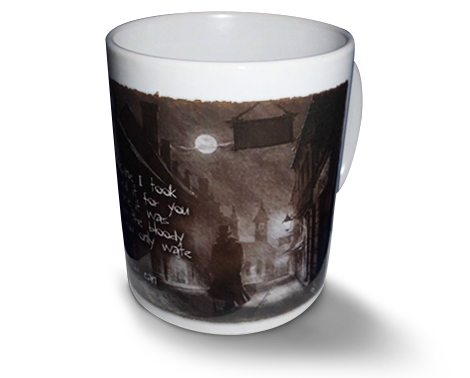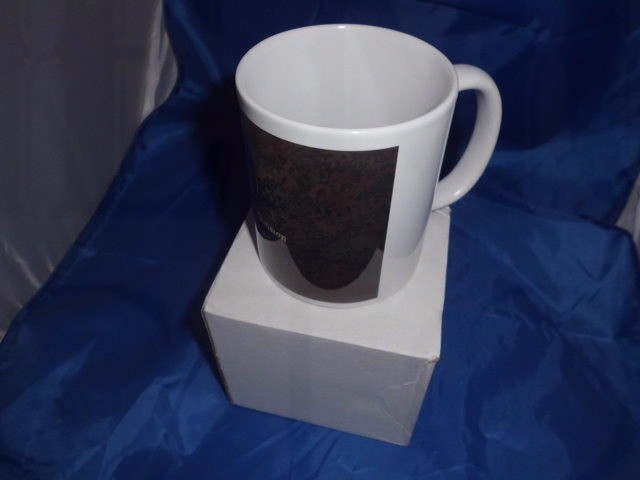2nd Panzer Division Das Reich military mug
11oz Panzer Division Das reich mug
Order of Battle for Das Reich as of June 1944
Following Order of Battle shows Das Reich 2nd SS-Panzer Division as of early 1944. It is worth noting that SS-Divisions were typically much larger than normal German army units, usually about twice the size in terms of manpower. An SS-Division was therefore a powerful force, especially the early ones such as 1st SS-Panzer Division Leibstandarte Adolf Hitler, 2nd SS-Panzer Division Das Reich and 3rd SS-Panzer Division Totenkopf. The average manpower of an SS-Panzer division was about 19,000, but the largest that I have seen was 22,300 for Leibstandarte and the smallest around 3000 for the later Divisions such as 38th SS-Grenadier Division Nibelungen.
A rough guide to the fighting efficiency and combat performance of an SS-Division can be gained from the number of Knights Crosses awarded to members during the war. Das Reich had a total of 69, more than any other SS-Division (the next was Leibstandarte with 58 and some of the SS Divisions formed later on in the war had none).
Das Reich in June 1944 was close to its full staff complement and would have had about 19,200 men in total. The split was approximately as follows:
SS-Divisional Headquarters ... 150 men. Heinrich Bernhard Lammerding was the commander in June 1944.
SS-Panzergrenadier Regiment 3 Deutschland ... 3,200 men
SS-Panzergrenadier Regiment 4 Der Führer ... 3,200 men. On the 10th of June, Sylvester Stadler was the commander of the Regiment, Adolf Diekmann the commander of the 1st Battalion, Helmut Kämpfe was the commander of the 3rd battalion and Otto Weidinger who became Regimental commander on 14th June was with the Regiment for familiarisation purposes.
SS-Panzer Regiment 2 ... 2,400 men
SS-Panzer Artillerie Regiment 2 ... 2,200 men
SS-Panzer Jäger Abteilung (Tank Hunter / Self Propelled Gun Detachment) 2 ... 510 men
SS-Aufklärungs Abteilung (Reconnaissance Detachment) 2 ... 950 men.
SS-Pioneer Abteilung (Pioneer Detachment) 2 ... 1000 men
SS-Nachrichten Abteilung (Signals Detachment) 2 ... 510 men
SS-Flak Abteilung (Anti-Aircraft Detachment) 2 ... 820 men
SS-Sturmgeschütz Abteilung (Assault Gun Detachment) 2 ... 350 men. Karl Gerlach was the ordnance officer on 9th June 1944.
SS-Nebelwerfer Abteilung (Smoke-screen Detachment)) 2 ... 480 men
Within days of the D-Day landings, the 'Das Reich' 2nd SS Panzer Division marched north through France to reinforce the front-line defenders of Hitler's Fortress Europe. Veterans of the bloddiest fighting of the Russian Front, 15,000 men with tanks and artillery, they were hounded for every mile of their march by saboteurs of the Resistance and agents of the Allied Special Forces. Along their route they took reprisals so savage they will live forever in the chronicles of the most appalling atrocities of war.
'My literary VC goes without doubt to Max Hastings for his Das Reich... the story of a march that left behind a trail of blood and death, torture and heroism....the slaughter and burning to death of 642 men, women and children of Oradour-sur-Glane...the hanging of 99 civilians from the lamp-posts of Tulle as a reprisal for Maquis action' Sunday Telegraph
2.ss first took part in the Campaigns in the West against the Low Countries and France in 1940, and did so as the SS-V.T.-Division. It first saw action in the main drive for Rotterdam. After Rotterdam the Division, along with other Divisions, intercepted a French Force and pushed them back to the area of Zeeland. Next, it was used to mop-up small pockets of resistance in the areas already captured by the Germans. The Division was then transfered to France and helped breach a stiffly defended canal line, and then participated in the drive on Paris. At the end of the Campaign, it had advanced all the way to the Spanish Frontier.Originally, the SS-V.T.-Division was composed of three of the original four SS-Standarten. LAH was the other SS-Standarten, and it was developed on its own. The other three SS-Standarten were Deutschland, Germania and Der Fuhrer. After the Western Campaign was over, the SS-V.T.-Division was reorganized. The SS-Standarten Germania was transfered out of the Division and along with the SS-Standarten, Nordland and Westland, formed the backbone of a different SS-Division, Germania, which was soon to become the Wiking Division. For the loss of Germania, the SS-V.T.-Division was given a SS-Totenkopfstandarte designated as SS-Infanterie Regiment 11. Soon after, the Division changed its title from V.T. to Deutschland, and soon after that, to Reich.During the period after the fall of France, the Division was stationed in France preparing for the invasion of England. The Division, now called Reich, was moved to Roumania to take part in the invasion of Yugoslavia and Greece in March of 1941. In April, 1941, Reich took part in the successful capture of Belgrade, the Capital of Yugoslavia. After the capture of Belgrade, the Division was moved to Poland to take part in the upcoming invasion of the Soviet Union.During the invasion of the Soviet Union, Reich fought with Army Group Center, taking part in the Battle of Yalnya near Smolensk, and then in the spearhead to capture Moscow. Reich came within a few miles of the Soviet Capital in November, 1941, reaching a sort of "High Water Mark" of the Germanadvance in the Soviet Union. With the Soviet Capital within sight of the Division, weather, massive losses and a major Soviet Winter Counter-Offensive pushed the Division back. After a period of very bloody losses for the Division, Reich was pulled out of the fighting and sent to France to refit as a Panzer-Grenadier Division. Part of the Division was left in the East, and they were titled Kampfgroup Ostendorf. Ostendork was sent to join Reich on June, 1942.In November, 1942, portions of the Division took part in an attempt to prevent the scuttling of the French Fleet at Toulon. Soon after, the Division was retitled again, this time to SS-Panzer-Grenadier-Division "Das Reich".Early in 1943, Das Reich was transferd back to the Eastern Front where it helped reclaim the crumbling central front around Kharkov. After helping recapture the city of Kharkov, Das Reich along with many other Divisions was thrown into a massive assault into the Kursk Salient, a huge bulge in the Soviet Front line around the area of Kursk. Das Reich pushed upwards of 40 miles into the southern sector of the bulge, but was pulled out of the battle along with the other SS-Division when the offensive was called off. After a period of brief encounters, Das Reich was refit once again, this time as SS-Panzer-Division "Das Reich". In doing so, it left a portion the Division in the East titled Kampfgroup Das Reich, and officially know as Kampfgroup Lammerding. The rest of the Division was transferd to the West to refit, and while doing so also took part in anti-partisan operations in France.In Winter, 1943/1944, another massive Soviet Winter Counter Offensive managed to encircle German units in the center of the front. The Kamfgroup that Das Reich left behind was one of the units encircled by the Soviet Offensive, and an assault by II. SS Panzer Korps managed to rescue the trapped elements of Das Reich. The Kampfgroup was then transfered to France to join the rest of the Division already station there. The remaining small portion of Das Reich left in the East was renamed Kampfgroup Weidinger and was envolved in the retreats through Proskurow abd Tarnopol.After the D-Day invasion in Normany, France, Das Reich was comitted to stop the Allied advance, and took part in the many attempts to stop the Allies near Caen and St. Lo. The Division recaptured Mortain, but was forced to retreat when it became apparent the Allies were going to encircle the Division along with a large number of other German units in the Falises Pocket. Thanks to the efforts of Das Reich along with the 9th SS-Panzer Division, a large number of German were able to escape the pocket and retreat to the east.Pulled back across the Seine River and then to behind the West Wall fortifications in France, the 2nd SS Panzer Division then took part in the operations to punch through the Ardennes Forest in December, 1944. Coming within sight of the River Meus, the Division was halted, and then slowly smashed by fierce Allied counter-attacks. Pulled out of the offensive, Das Reich was transfered into Germany to again refit, and then to take part in the last German offenisve of the war in Hungary to attempt to break the seige around Budapest. This offensive also ground to a halt, and Das Reich spent the rest of the war more-or-less fighting in parts from Dresden, to Prague to Vienna. In the end, most of the Division managed to escape to the West to surrender to the Americans.
General Composition 44-45Stab der DivisionSS-Standarte Germania (Removed from Division November, 1940) 3.SS-Panzergrenadier-Regiment "Deutschland4.SS-Panzergrenadier-Regiment "Der Fuhrer"SS-Infanterie-Regiment "Langemarck" (Removed Summer, 1943)SS-Infanterie-Regiment 11 (Disbanded November, 1940) 2.SS-Panzer-Regiment2.SS-Panzerjäger-Abteilung2.SS-Sturmgeschutz-Abteilung2.SS-Panzer-Artillerie-Regiment2.SS-Flak-Abteilung2.SS-Werfer-Abteilung2.SS-Panzer-Nachrichten-Abteilung2.SS-Panzer-Aufklarungs-Abteilung2.SS-Panzer-Pionier-Batallion2.SS-Kradschutzen-Batallion2.SS-Dina2.SS-Feldlazarett2.SS-Kriegsberichter-Zug2.SS-Feldgendarmerie-Trupp2.SS-Feldersatz-Battillon
SS-Division Reich (mot.)SS-Regiment DeutschlandSS-Regiment Der Führer11.SS-Infanterie-RegimentSS-Artillerie-Regiment ReichSS-Panzerjäger-Abteilung ReichSS-Pioneer-Abteilung ReichSS-Flak-Abteilung ReichSS-Nachrichten-AbteilungReich Divisional Support Troops
June, 1941SS-Regiment Der FuhrerSS-Regiment DeutschlandSS-Regiment 11SS-Kradschutzen-AbteilungSS-Artillerie-RegimentSS-Aufklarung-AbteilungSS-Panzerjäger-AbteilungSS-Flak-AbteilungSS-Pioneer-AbteilungSS-Sturmgeschutz-Batterie
SS-Verfüngs-DivisionI,II,III/ss.VT-Standarte Der FuhrerI,II,III/ss.VT-Standarte DeutschlandI,II,III/ss.VT-Standarte GermaniaI,II,III/ss.VT-Artillerie-StandarteIV,V/ss.VT-Artillerie-Standartess.VT-Aufklarung-Abteilungss.VT-Panzerjäger Battalion (formed 10 June 1939)ss.VT-Flak-Abteilung (formed 10 June 1939)ss.VT-Pioneer-Abteilungss.VT-Nachrichten-Abteilungss.VT-Panzerabwehr-Abteilungss.VT-Flak-AbteilungSS-Ersatz-Abteilung
SS-Regiment Germania, plus other divisional elements, detached on 1 Dec 1940 to form cadre for SS-Division Wiking; SS-Regiment 11, formerly SS-Totenkopf-Standarte 11 attached in its place; division designated SS-Divsion Reich (mot.), 28 Jan 1941







